Listeners Sensitivity to Different Locations of Diffusive Surfaces in Performance Spaces: The Case of a Shoebox Concert Hall †
Abstract
:1. Introduction
2. Method
2.1. Objective Measurements
2.1.1. Hall Description
2.1.2. Hall Acoustic Conditions and Measurements
2.1.3. Objective Analyses
2.2. Subjective Investigation
2.2.1. Test Subjects and Experimental Environment
2.2.2. ABX Method
2.2.3. Test Procedure
- “How strong is the difference?” The answer was given on a 0–10 scale.
- “What kind of difference could you perceive?” The answer was given by selecting the relevant attributes (coloration, spaciousness, clarity, reverberance, and loudness) that have been perceived as different. Listeners could choose more than one option or indicate other unincluded attributes.
- “Which signal do you prefer?” The answer was given by choosing between A and B.
3. Results
3.1. Objective Results
3.2. Subjective Results
4. Discussion
Limitations of the Study
5. Conclusions
- The objective parameters are not significantly influenced by the diffusive surface location. No clear trend can be observed for T30, C80, D50, and Ts variations in the different configurations in both the absorptive (-A) and reflective (-R) conditions. EDT results as the most affected parameter.
- The perceived differences between the front-rear asymmetric conditions of the diffusive surface location with respect to the listener position do not show significant differences. However, some of the listeners could still indicate a few differences relying on two or more attributes (reverberance, coloration, and spaciousness). Reverberance seems to be the main attribute when the orchestra and pink noise samples are compared in the reflective condition.
Author Contributions
Funding
Acknowledgments
Conflicts of Interest
Appendix A
| ΔEDT [%] | ΔT30 [%] | ΔC80 [dB] | ΔD50 [%] | ΔTs [s] | ||||||||||||
|---|---|---|---|---|---|---|---|---|---|---|---|---|---|---|---|---|
| R | d-S1 [m] | Df-Dm | Df-Dr | Dm-Dr | Df-Dm | Df-Dr | Dm-Dr | Df-Dm | Df-Dr | Dm-Dr | Df-Dm | Df-Dr | Dm-Dr | Df-Dm | Df-Dr | Dm-Dr |
| 6 | 7.37 | −0.8 | −7.4 | −6.6 | −1.1 | 1.4 | 2.5 | 0.2 | 0.1 | 0.0 | 0.0 | 2.1 | 2.1 | −0.004 | −0.012 | −0.008 |
| 5 | 7.48 | 2.0 | 2.9 | 0.9 | 2.3 | 3.1 | 0.8 | −0.3 | −0.6 | −0.3 | 2.0 | 0.8 | −1.3 | −0.001 | 0.004 | 0.005 |
| 4 | 7.87 | −0.2 | 3.7 | 3.9 | 2.3 | 3.7 | 1.3 | −0.2 | 0.2 | 0.3 | 3.8 | 5.0 | 1.2 | 0.002 | −0.004 | −0.006 |
| 3 | 8.4 | 6.8 | 2.6 | −3.9 | −0.1 | −0.1 | 0.0 | −0.6 | −0.5 | 0.2 | 0.5 | 0.9 | 0.4 | 0.009 | 0.007 | −0.002 |
| 2 | 9.22 | 10.3 | 4.9 | −4.8 | 0.5 | −1.2 | −1.7 | −1.5 | −0.9 | 0.6 | −7.6 | −5.8 | 1.8 | 0.022 | 0.012 | −0.010 |
| 12 | 10 | 3.0 | 7.5 | 4.4 | 1.0 | 1.2 | 0.2 | 0.2 | 0.8 | 0.6 | −0.7 | 4.1 | 4.8 | 0.002 | −0.003 | −0.005 |
| 11 | 10.08 | −2.2 | −5.9 | −3.7 | 0.0 | 2.4 | 2.4 | −1.2 | −1.0 | 0.2 | −7.0 | −4.6 | 2.4 | 0.002 | 0.002 | −0.001 |
| 1 | 10.3 | 2.0 | 3.5 | 1.5 | 4.3 | 3.5 | −0.8 | 0.0 | 0.6 | 0.6 | 0.0 | 3.0 | 3.0 | 0.006 | −0.001 | −0.008 |
| 10 | 10.38 | 2.6 | 4.5 | 1.9 | 1.3 | 0.5 | −0.8 | 0.4 | 0.2 | −0.2 | 0.0 | 0.9 | 1.0 | −0.002 | 0.000 | 0.002 |
| 9 | 10.79 | 3.8 | −0.5 | −4.1 | 0.5 | −0.8 | −1.3 | −0.8 | −0.3 | 0.5 | −4.3 | −2.2 | 2.1 | 0.010 | 0.004 | −0.006 |
| 8 | 11.43 | 2.1 | 6.7 | 4.6 | 1.6 | −0.7 | −2.3 | −0.2 | 0.0 | 0.2 | 0.9 | 1.1 | 0.2 | 0.008 | 0.004 | −0.003 |
| 7 | 12.1 | −1.6 | −3.4 | −1.8 | 1.3 | 0.7 | −0.5 | 0.0 | 0.3 | 0.3 | 1.2 | 2.4 | 1.1 | 0.003 | −0.005 | −0.008 |
| 18 | 12.63 | 2.2 | 0.1 | −2.0 | −3.9 | 0.2 | 4.3 | −0.7 | −0.6 | 0.1 | −5.6 | −2.1 | 3.5 | 0.010 | 0.010 | 0.000 |
| 17 | 12.69 | 1.4 | −0.2 | −1.6 | −0.5 | 1.2 | 1.7 | 0.4 | 0.5 | 0.1 | −1.1 | −1.4 | −0.3 | −0.002 | −0.001 | 0.000 |
| 16 | 12.93 | 10.9 | 6.7 | −3.9 | −0.2 | 0.6 | 0.8 | −0.5 | −0.1 | 0.4 | 0.2 | 1.9 | 1.7 | 0.013 | 0.001 | −0.012 |
| 15 | 13.26 | 7.5 | 1.5 | −5.6 | 2.6 | 2.6 | 0.0 | −0.5 | −0.7 | −0.2 | 0.0 | −1.2 | −1.2 | 0.008 | 0.005 | −0.003 |
| 14 | 13.79 | −7.9 | −3.5 | 4.8 | 2.2 | 1.6 | −0.6 | 0.9 | 0.6 | −0.3 | 1.1 | −1.2 | −2.3 | −0.014 | −0.009 | 0.004 |
| 13 | 14.35 | 0.7 | −3.2 | −3.9 | 1.6 | 1.3 | −0.3 | −0.4 | −0.5 | −0.1 | 1.8 | −1.4 | −3.2 | −0.002 | −0.003 | −0.001 |
| 24 | 15.26 | −10.3 | −11.7 | −1.6 | 1.1 | 2.6 | 1.4 | 0.2 | −0.1 | −0.3 | −1.7 | −1.4 | 0.2 | −0.014 | −0.009 | 0.005 |
| 23 | 15.31 | 1.0 | −1.2 | −2.2 | −3.5 | −2.2 | 1.3 | 0.4 | −0.5 | −0.9 | 2.5 | −1.7 | −4.2 | −0.005 | 0.002 | 0.007 |
| 22 | 15.51 | −4.2 | 1.8 | 6.3 | −0.8 | −0.4 | 0.4 | 0.5 | 0.6 | 0.1 | 5.7 | 4.6 | −1.1 | −0.011 | −0.007 | 0.004 |
| 21 | 15.76 | 4.2 | 0.2 | −3.9 | 0.0 | −0.2 | −0.3 | −0.3 | −0.6 | −0.3 | 0.5 | 0.2 | −0.3 | 0.003 | 0.004 | 0.000 |
| 20 | 16.23 | 2.6 | 2.9 | 0.4 | −2.7 | −2.8 | −0.1 | −0.5 | −1.1 | −0.6 | −3.7 | −4.3 | −0.7 | 0.007 | 0.014 | 0.006 |
| 19 | 16.71 | 3.9 | 3.7 | −0.2 | 1.2 | 0.8 | −0.3 | 1.3 | 0.0 | −1.3 | 6.7 | 2.4 | −4.3 | −0.015 | 0.001 | 0.016 |
| ΔEDT [%] | ΔT30 [%] | ΔC80 [dB] | ΔD50 [%] | ΔTs [s] | ||||||||||||
|---|---|---|---|---|---|---|---|---|---|---|---|---|---|---|---|---|
| R | d-S2 [m] | Df-Dm | Df-Dr | Dm-Dr | Df-Dm | Df-Dr | Dm-Dr | Df-Dm | Df-Dr | Dm-Dr | Df-Dm | Df-Dr | Dm-Dr | Df-Dm | Df-Dr | Dm-Dr |
| 2 | 6.01 | 0.6 | −2.7 | −3.2 | 0.4 | 3.8 | 3.4 | 0.2 | 0.2 | 0.1 | 2.9 | 2.1 | −0.8 | −0.006 | −0.010 | −0.004 |
| 3 | 6.02 | −3.0 | −2.7 | 0.3 | 2.0 | 1.6 | −0.4 | −0.3 | −0.4 | −0.1 | 0.1 | −1.8 | −1.9 | 0.002 | 0.000 | −0.002 |
| 1 | 6.28 | −3.7 | −6.7 | −3.1 | 1.7 | 0.8 | −0.8 | −1.4 | −1.5 | −0.1 | −6.6 | −6.0 | 0.7 | 0.007 | 0.005 | −0.002 |
| 4 | 6.32 | 10.4 | 3.4 | −6.4 | −5.2 | −4.0 | 1.3 | −0.6 | −0.8 | −0.2 | −0.5 | −1.0 | −0.6 | 0.010 | 0.007 | −0.003 |
| 5 | 6.96 | 0.8 | −0.4 | −1.1 | 0.9 | 3.2 | 2.3 | 0.0 | 0.5 | 0.5 | 3.6 | 4.8 | 1.2 | 0.001 | −0.010 | −0.011 |
| 6 | 7.69 | −5.9 | 0.2 | 6.5 | −5.0 | −1.8 | 3.4 | −0.7 | 0.0 | 0.7 | −6.5 | −3.3 | 3.2 | 0.001 | −0.003 | −0.004 |
| 8 | 8.63 | 4.1 | 6.2 | 2.0 | −1.5 | 1.2 | 2.7 | −0.6 | −0.3 | 0.2 | −0.2 | 0.8 | 0.9 | 0.013 | 0.006 | −0.007 |
| 9 | 8.64 | 3.0 | 3.8 | 0.8 | −0.4 | −0.2 | 0.2 | −0.2 | −0.5 | −0.2 | −2.9 | −2.5 | 0.4 | 0.006 | 0.008 | 0.002 |
| 7 | 8.82 | 7.7 | 2.7 | −4.6 | −0.9 | −0.7 | 0.2 | −0.9 | −0.6 | 0.3 | −0.9 | 0.0 | 0.9 | 0.007 | 0.000 | −0.007 |
| 10 | 8.85 | 3.1 | −3.0 | −5.9 | −1.3 | −0.4 | 0.9 | −0.6 | −1.2 | −0.5 | −4.3 | −5.2 | −0.9 | 0.012 | 0.006 | −0.005 |
| 11 | 9.32 | 1.0 | −0.2 | −1.2 | −2.9 | −1.7 | 1.3 | 0.9 | 0.4 | −0.5 | 4.8 | 3.6 | −1.2 | −0.010 | −0.007 | 0.004 |
| 12 | 9.87 | −4.9 | −2.4 | 2.7 | −4.9 | −1.6 | 3.4 | −0.5 | −0.1 | 0.4 | −3.9 | −2.1 | 1.8 | 0.002 | 0.000 | −0.002 |
| 14 | 11.25 | −3.8 | −1.9 | 2.0 | −0.2 | 0.5 | 0.7 | 0.0 | 0.4 | 0.4 | 1.1 | 2.8 | 1.7 | −0.003 | −0.006 | −0.003 |
| 15 | 11.26 | 13.7 | 12.7 | −0.8 | −1.8 | −2.2 | −0.4 | 0.3 | 0.8 | 0.5 | 0.2 | −0.1 | −0.3 | 0.003 | 0.001 | −0.002 |
| 13 | 11.4 | −5.9 | 2.3 | 8.7 | 1.6 | −2.9 | −4.5 | 1.4 | −0.1 | −1.5 | 6.7 | −0.7 | −7.4 | −0.023 | 0.002 | 0.026 |
| 16 | 11.42 | −4.8 | −3.5 | 1.3 | −1.7 | −1.6 | 0.1 | 0.0 | −0.6 | −0.6 | −1.2 | −1.6 | −0.4 | −0.009 | −0.001 | 0.008 |
| 17 | 11.79 | −4.7 | −0.3 | 4.6 | −0.9 | −1.3 | −0.4 | 0.5 | 0.4 | −0.1 | 1.0 | 1.5 | 0.5 | −0.010 | −0.007 | 0.002 |
| 18 | 12.23 | −0.2 | −0.5 | −0.3 | −0.2 | −1.0 | −0.8 | 0.0 | −0.1 | −0.1 | 0.9 | −0.4 | −1.3 | 0.005 | 0.000 | −0.005 |
| 20 | 13.87 | −7.5 | −4.4 | 3.4 | −1.1 | −2.3 | −1.3 | 1.0 | −0.2 | −1.3 | 1.3 | −1.3 | −2.6 | −0.011 | 0.000 | 0.011 |
| 21 | 13.88 | −1.9 | −3.0 | −1.1 | 0.4 | −0.3 | −0.8 | −1.0 | −0.8 | 0.2 | −2.8 | −0.8 | 1.9 | 0.004 | −0.001 | −0.005 |
| 19 | 14 | −3.9 | −1.6 | 2.4 | 1.6 | −1.3 | −2.9 | 0.7 | −0.4 | −1.1 | 3.1 | −0.5 | −3.6 | −0.009 | 0.001 | 0.010 |
| 22 | 14.02 | 6.8 | 7.8 | 0.9 | 0.0 | −0.9 | −1.0 | 0.5 | −0.6 | −1.2 | 4.0 | 2.6 | −1.4 | −0.002 | 0.007 | 0.008 |
| 23 | 14.31 | 2.2 | 4.7 | 2.5 | −0.3 | 1.6 | 1.9 | 0.2 | −0.1 | −0.2 | 2.0 | 3.4 | 1.3 | −0.003 | 0.001 | 0.003 |
| 24 | 14.68 | −1.3 | −2.7 | −1.4 | −1.7 | 0.0 | 1.8 | −0.1 | −0.9 | −0.8 | 3.2 | −0.3 | −3.6 | −0.003 | 0.002 | 0.005 |
| ΔEDT [%] | ΔT30 [%] | ΔC80 [dB] | ΔD50 [%] | ΔTs [s] | ||||||||||||
|---|---|---|---|---|---|---|---|---|---|---|---|---|---|---|---|---|
| R | d-S1 [m] | Df-Dm | Df-Dr | Dm-Dr | Df-Dm | Df-Dr | Dm-Dr | Df-Dm | Df-Dr | Dm-Dr | Df-Dm | Df-Dr | Dm-Dr | Df-Dm | Df-Dr | Dm-Dr |
| 6 | 7.37 | −4.1 | −7.1 | −3.1 | −1.2 | 3.1 | 4.3 | −0.1 | −0.2 | 0 | −1.3 | −2.7 | −1.4 | 0.001 | 0.002 | 0.001 |
| 5 | 7.48 | −2.5 | −0.5 | 2.1 | 1.2 | 1 | −0.3 | 0.3 | −0.1 | −0.5 | 1.5 | −2.6 | −4.1 | 0.000 | 0.004 | 0.003 |
| 4 | 7.87 | 6.2 | −0.4 | −6.2 | −2.4 | 0.2 | 2.6 | −0.7 | −1.2 | −0.5 | −3.3 | −3.8 | −0.5 | 0.005 | 0.005 | 0.000 |
| 3 | 8.4 | 4.6 | 8.6 | 3.8 | 1.5 | 0.8 | −0.7 | −0.6 | −1.4 | −0.8 | 1.9 | −1.4 | −3.3 | 0.001 | 0.005 | 0.005 |
| 2 | 9.22 | −5.8 | −2.1 | 3.9 | 1.4 | 3.7 | 2.3 | −0.3 | −0.6 | −0.4 | −8.1 | −8.3 | −0.2 | 0.005 | 0.007 | 0.002 |
| 12 | 10 | −6.5 | −2.5 | 4.2 | 1.8 | 2.9 | 1 | 0.2 | 0.3 | 0.2 | −1.8 | −1.2 | 0.6 | 0.000 | 0.001 | 0.002 |
| 11 | 10.08 | −5.5 | −1.4 | 4.3 | 4.1 | 6.2 | 2 | −0.2 | −0.3 | −0.1 | 2.1 | 2.1 | 0 | −0.002 | 0.000 | 0.001 |
| 1 | 10.3 | 5.8 | 9 | 3 | 2.2 | 6.1 | 3.9 | −0.1 | 0.1 | 0.2 | −1.7 | −0.3 | 1.3 | 0.000 | 0.002 | 0.002 |
| 10 | 10.38 | −3 | 1.7 | 4.8 | 1.3 | 3.7 | 2.4 | 0.4 | 0.4 | 0.1 | 3.6 | 3.6 | 0 | −0.003 | −0.002 | 0.001 |
| 9 | 10.79 | 9.7 | 4.1 | −5.2 | −1.1 | 2.3 | 3.4 | −1.5 | −0.6 | 0.9 | −2.9 | −1.8 | 1 | 0.004 | 0.002 | −0.002 |
| 8 | 11.43 | −3.1 | 0.2 | 3.5 | 0.7 | 2 | 1.3 | −0.9 | −0.6 | 0.3 | −7.7 | −5.4 | 2.3 | 0.004 | 0.004 | 0.001 |
| 7 | 12.1 | −1.8 | −2.1 | −0.3 | −0.4 | 3.8 | 4.2 | −0.6 | −0.5 | 0 | 2.8 | −2 | −4.8 | 0.002 | 0.002 | 0.000 |
| 18 | 12.63 | 7.2 | 6.8 | −0.4 | 2 | 1.3 | −0.7 | −1.1 | −0.5 | 0.6 | −10.7 | −9.1 | 1.6 | 0.009 | 0.007 | −0.002 |
| 17 | 12.69 | −10 | −4.3 | 6.4 | 1.4 | 0.8 | −0.6 | 0.5 | 0.4 | −0.1 | 1.1 | −0.5 | −1.6 | −0.004 | −0.001 | 0.004 |
| 16 | 12.93 | −3.1 | 3.4 | 6.6 | 0.7 | 3.5 | 2.8 | 0.3 | −0.4 | −0.6 | −1 | −0.3 | 0.8 | −0.001 | 0.002 | 0.003 |
| 15 | 13.26 | −0.3 | 3.3 | 3.6 | 0.7 | −1.2 | −1.8 | −0.2 | −1 | −0.8 | 1.8 | −3.2 | −5.1 | 0.000 | 0.005 | 0.005 |
| 14 | 13.79 | 4.5 | 5 | 0.5 | −0.5 | 4.5 | 5 | 0.3 | 0 | −0.3 | 4.2 | 2.6 | −1.6 | −0.001 | 0.002 | 0.002 |
| 13 | 14.35 | −4.6 | 9.2 | 14.5 | −4.2 | 2.5 | 7 | −0.4 | −0.6 | −0.2 | 2.1 | 0.5 | −1.6 | −0.004 | 0.002 | 0.007 |
| 24 | 15.26 | −4.5 | −0.5 | 4.2 | −2 | −0.2 | 1.8 | 0 | −0.3 | −0.3 | −1.8 | −2.2 | −0.4 | 0.002 | 0.002 | 0.000 |
| 23 | 15.31 | −6.8 | −1.1 | 6.2 | 0.8 | 4.1 | 3.3 | 0.2 | −0.1 | −0.2 | 2.7 | −2 | −4.7 | −0.002 | 0.000 | 0.003 |
| 22 | 15.51 | 3 | 3.2 | 0.2 | 0.6 | 0.3 | −0.3 | 0.7 | 0.2 | −0.5 | 7.2 | 4.7 | −2.5 | −0.004 | −0.001 | 0.003 |
| 21 | 15.76 | −3.9 | 2.7 | 6.9 | 1.9 | 0.4 | −1.5 | −0.1 | 0.5 | 0.6 | 2.1 | 6.2 | 4.1 | −0.001 | −0.002 | −0.001 |
| 20 | 16.23 | 4 | 5.9 | 1.8 | −1 | −1.1 | −0.1 | −0.8 | −0.6 | 0.2 | 0 | 3 | 3.1 | 0.003 | 0.001 | −0.002 |
| 19 | 16.71 | −5.5 | −12.1 | −7 | 0.9 | 3.2 | 2.3 | 1 | 1 | 0.1 | −0.3 | 0 | 0.2 | −0.004 | −0.002 | 0.002 |
| ΔEDT [%] | ΔT30 [%] | ΔC80 [dB] | ΔD50 [%] | ΔTs [s] | ||||||||||||
|---|---|---|---|---|---|---|---|---|---|---|---|---|---|---|---|---|
| R | d-S2 [m] | Df-Dm | Df-Dr | Dm-Dr | Df-Dm | Df-Dr | Dm-Dr | Df-Dm | Df-Dr | Dm-Dr | Df-Dm | Df-Dr | Dm-Dr | Df-Dm | Df-Dr | Dm-Dr |
| 2 | 6.01 | −3 | −2.7 | 0.3 | −0.4 | 4.8 | 5.3 | 0.2 | 0.1 | −0.1 | 1.8 | −0.8 | −2.6 | −0.002 | 0.000 | 0.003 |
| 3 | 6.02 | 11.3 | 2.5 | −8 | 0.5 | 3.2 | 2.6 | 0.1 | 0.2 | 0.1 | 0.2 | −1.4 | −1.6 | 0.001 | 0.002 | 0.001 |
| 1 | 6.28 | 2.2 | −3.5 | −5.6 | 2.4 | 3.9 | 1.4 | −1 | −0.3 | 0.7 | −3.1 | −2.3 | 0.9 | 0.004 | 0.003 | −0.001 |
| 4 | 6.32 | −5.2 | 6.9 | 12.7 | 5.3 | 3.8 | −1.4 | −0.2 | −1 | −0.8 | 1.2 | −3.7 | −4.9 | −0.001 | 0.006 | 0.007 |
| 5 | 6.96 | −6.6 | −10.3 | −4 | 1.9 | 2.4 | 0.5 | 0.8 | 0.4 | −0.4 | 2.2 | −1.5 | −3.7 | −0.003 | 0.000 | 0.003 |
| 6 | 7.69 | −3 | 2.9 | 6.1 | 0 | 1.1 | 1.1 | −0.5 | −0.8 | −0.3 | −5.5 | −8.2 | −2.7 | 0.005 | 0.008 | 0.003 |
| 8 | 8.63 | 5.1 | 10.9 | 5.5 | 0.4 | −1.1 | −1.5 | 0.3 | −0.2 | −0.5 | 0.6 | 2.1 | 1.5 | 0.001 | 0.001 | 0.000 |
| 9 | 8.64 | 2.4 | 0.2 | −2.2 | 1 | 2.5 | 1.5 | −0.4 | −0.3 | 0.1 | −2.2 | −3 | −0.8 | 0.002 | 0.002 | 0.000 |
| 7 | 8.82 | 7.1 | 4.7 | −2.2 | −4.3 | −1.7 | 2.8 | −1.3 | −1.2 | 0.2 | −9 | −6.8 | 2.2 | 0.010 | 0.007 | −0.003 |
| 10 | 8.85 | 10.9 | 13 | 1.9 | 0.6 | 1.2 | 0.5 | −0.6 | −1.4 | −0.8 | −1.5 | −5.8 | −4.2 | 0.005 | 0.009 | 0.004 |
| 11 | 9.32 | −12.8 | 2.6 | 17.6 | 3.1 | 2.1 | −1 | 0 | −1.2 | −1.2 | −7.3 | −8.7 | −1.4 | 0.001 | 0.008 | 0.008 |
| 12 | 9.87 | −7.1 | −0.7 | 6.9 | 5 | 2.4 | −2.5 | 0.6 | −0.1 | −0.7 | −1.7 | −4.5 | −2.8 | −0.003 | 0.003 | 0.006 |
| 14 | 11.25 | −3.1 | 5.8 | 9.2 | 0 | 2.2 | 2.1 | −0.3 | 0 | 0.3 | −4 | 1.8 | 5.8 | 0.004 | 0.003 | −0.001 |
| 15 | 11.26 | −5.5 | 3.8 | 9.9 | 0.3 | 0.1 | −0.3 | 0.6 | −0.4 | −1 | 0.8 | −3.3 | −4.1 | −0.002 | 0.005 | 0.006 |
| 13 | 11.4 | 12.1 | 6.4 | −5.1 | −4.6 | 3.9 | 8.8 | −0.1 | −0.5 | −0.4 | 0 | −2.5 | −2.4 | 0.001 | 0.004 | 0.003 |
| 16 | 11.42 | 2.6 | 3.7 | 1 | −0.6 | 2.1 | 2.7 | −0.4 | −0.5 | −0.1 | −2.4 | −1.4 | 1 | 0.004 | 0.005 | 0.001 |
| 17 | 11.79 | 14.5 | 6 | −7.5 | −0.2 | 1.2 | 1.4 | −0.2 | 0.4 | 0.5 | 2 | 1.9 | −0.2 | 0.005 | 0.003 | −0.002 |
| 18 | 12.23 | 7.1 | 2.5 | −4.3 | 2.2 | 1.5 | −0.6 | 0.1 | 0.3 | 0.2 | 0.2 | −2.1 | −2.3 | 0.003 | 0.003 | 0.000 |
| 20 | 13.87 | 4.3 | 1.6 | −2.6 | 1.1 | 0.5 | −0.5 | −0.2 | −0.5 | −0.3 | −5.8 | −4.6 | 1.2 | 0.003 | 0.004 | 0.001 |
| 21 | 13.88 | −2 | 1.9 | 3.9 | 4.6 | 1.8 | −2.7 | −0.1 | −1.6 | −1.5 | −7.4 | −10.4 | −3 | 0.005 | 0.009 | 0.004 |
| 19 | 14 | −6.5 | 1.6 | 8.6 | 6.1 | 3.6 | −2.3 | 0.6 | 0.5 | −0.1 | −0.7 | −1.6 | −0.9 | −0.002 | 0.002 | 0.004 |
| 22 | 14.02 | 6.3 | 8.6 | 2.1 | −1.7 | −0.3 | 1.5 | −0.8 | −0.8 | 0 | 0.5 | −0.6 | −1.1 | 0.003 | 0.004 | 0.001 |
| 23 | 14.31 | −8.4 | 5.1 | 14.7 | 0.7 | 1.1 | 0.4 | −0.3 | −0.1 | 0.3 | −2.6 | −0.4 | 2.1 | 0.004 | 0.003 | −0.001 |
| 24 | 14.68 | 2.7 | 7.7 | 4.9 | −1.3 | −0.4 | 0.9 | −0.6 | −0.5 | 0.1 | −6.4 | −2.7 | 3.6 | 0.005 | 0.004 | −0.001 |
References
- Beranek, L. Concert Halls and Opera Houses: How They Sound; Acoustical Society of America: New York, NY, USA, 1996. [Google Scholar]
- Haan, C.; Fricke, F.R. An evaluation of the importance of surface diffusivity in concert halls. Appl. Acoust. 1997, 51, 53–69. [Google Scholar] [CrossRef]
- Cox, T.; D’Antonio, P. Acoustic Absorbers and Diffusers. Theory, Design and Application; CRC Press: Boca Raton, FL, USA, 2007. [Google Scholar]
- Ryu, J.K.; Jeon, J.Y. Subjective and objective evaluations of a scattered sound field in a scale model opera house. J. Acoust. Soc. Am. 2008, 124, 1538. [Google Scholar] [CrossRef]
- Hanyu, T. A theoretical framework for quantitatively characterizing sound field diffusion based on scattering coefficient and absorption coefficient of walls. J. Acoust. Soc. Am. 2010, 128, 1140. [Google Scholar] [CrossRef] [PubMed]
- Jeon, J.Y.; Kim, J.H.; Seo, C.K. Acoustical remodeling of a large fan-type auditorium to enhance sound strength and spatial responsiveness for symphonic music. Appl. Acoust. 2012, 73, 1104–1111. [Google Scholar] [CrossRef]
- Shtrepi, L.; Astolfi, A.; D’Antonio, G.; Guski, M. Objective and perceptual evaluation of distance-dependent scattered sound effects in a small variable-acoustics hall. J. Acoust. Soc. Am. 2016, 140, 3651–3662. [Google Scholar] [CrossRef] [PubMed]
- Jeon, J.Y.; Kim, Y.S.; Lim, H.; Cabrera, D. Preferred positions for solo, duet, and quartet performers on stage in concert halls: In situ experiment with acoustic measurements. Build. Environ. 2015, 93, 267–277. [Google Scholar] [CrossRef]
- Kim, Y.H.; Kim, J.H.; Jeon, J.Y. Scale Model Investigations of Diffuser Application Strategies for Acoustical Design of Performance Venues. Acta Acust. United Acust. 2011, 97, 791–799. [Google Scholar] [CrossRef]
- Lokki, T.; Pätynen, J.; Tervo, S.; Siltanen, S.; Savioja, L. Engaging concert hall acoustics is made up of temporal envelope preserving reflections. J. Acoust. Soc. Am. 2011, 129, EL223–EL228. [Google Scholar] [CrossRef] [Green Version]
- Robinson, P.W.; Pätynen, J.; Lokki, T.; Jang, H.S.; Jeon, J.Y.; Xiang, N. The role of diffusive architectural surfaces on auditory spatial discrimination in performance venues. J. Acoust. Soc. Am. 2013, 133, 3940–3950. [Google Scholar] [CrossRef] [PubMed]
- Jeon, J.Y.; Jo, H.I.; Seo, R.; Kwak, K.H. Objective and subjective assessment of sound diffuseness in musical venues via computer simulations and a scale model. Build. Environ. 2020, 173. [Google Scholar] [CrossRef]
- Shtrepi, L. Investigation on the diffusive surface modeling detail in geometrical acoustics based simulations. J. Acoust. Soc. Am. 2019, 145, EL215–EL221. [Google Scholar] [CrossRef] [PubMed] [Green Version]
- Shtrepi, L.; Astolfi, A.; Puglisi, G.E.; Masoero, M. Effects of the Distance from a Diffusive Surface on the Objective and Perceptual Evaluation of the Sound Field in a Small Simulated Variable-Acoustics Hall. Appl. Sci. 2017, 7, 224. [Google Scholar] [CrossRef] [Green Version]
- Shtrepi, L.; Astolfi, A.; Pelzer, S.; Vitale, R.; Rychtáriková, M. Objective and perceptual assessment of the scattered sound field in a simulated concert hall. J. Acoust. Soc. Am. 2015, 138, 1485–1497. [Google Scholar] [CrossRef]
- Shtrepi, L.; Rychtáriková, M.; Astolfi, A. The Influence of a Volume Scale-Factor on Scattering Coefficient Effects in Room Acoustics. Build. Acoust. 2014, 21, 153–166. [Google Scholar] [CrossRef]
- ISO3382-1. Acoustics-Measurement of Room Acoustic Parameters-Part 1: Performance of Spaces; International Standards Organization: Geneva, Switzerland, 2009. [Google Scholar]
- Jeon, J.Y.; Seo, C.K.; Kim, Y.H.; Lee, P.J. Wall diffuser designs for acoustical renovation of small performing spaces. Appl. Acoust. 2012, 73, 828–835. [Google Scholar] [CrossRef]
- Jeon, J.Y.; Jang, H.S.; Kim, Y.H.; Vorlander, M. Influence of wall scattering on the early fine structures of measured room impulse responses. J. Acoust. Soc. Am. 2015, 137, 1108–1116. [Google Scholar] [CrossRef]
- Torres, R.; Kleiner, M.; Dalenback, B.-I. Audibility of “Diffusion” in room acoustics auralization: An initial investigation. Acust. Acta Acust. 2000, 86, 919–927. [Google Scholar]
- Takahashi, D.; Takahashi, R. Sound Fields and Subjective Effects of Scattering by Periodic-Type Diffusers. J. Sound Vib. 2002, 258, 487–497. [Google Scholar] [CrossRef]
- Singh, P.K.; Ando, Y.; Kurihara, Y. Individual subjective diffuseness responses of filtered noise sound fields. Acustica 1994, 80, 471–477. [Google Scholar]
- Vitale, R. Perceptual Aspects of Sound Scattering in Concert Halls. Ph.D. Thesis, Logos Verlag Berlin GmbH, Aachen, Germany, 2015. [Google Scholar]
- ISO17497-1. Acoustics-Measurement of Sound Scattering Properties of Surfaces. Part 1: Measurement of the Random-Incidence Scattering Coefficient in a Reverberation Room; International Standards Organization: Geneva, Switzerland, 2004. [Google Scholar]
- ISO17497-2. Acoustics-Sound-Scattering Properties of Surfaces. Part 2: Measurement of the Directional Diffusion Coefficient in a Free Field; International Standards Organization: Geneva, Switzerland, 2012. [Google Scholar]
- Shtrepi, L.; Astolfi, A.; D’Antonio, G.; Vannelli, G.; Barbato, G.; Mauro, S.; Prato, A. Accuracy of the random-incidence scattering coefficient measurement. Appl. Acoust. 2016, 106, 23–35. [Google Scholar] [CrossRef]
- Peutz, V. Nouvelle examen des theories de reverberation. Rev. D’acoust. 1981, 57, 99–109. [Google Scholar]
- Peutz, V. The Variable Acoustics of the Espace de Projection of Ircam (Paris). In Proceedings of the 59th International Audio Engineering Society Convention, Hamburg, Germany, 28 March 1978. [Google Scholar]
- ITA TOOLBOX. Available online: http://www.ita-toolbox.org/ (accessed on 26 May 2020).
- Farina, A. Simultaneous measurement of impulse response and distortion with a swept-sine technique. In Proceedings of the 108th International Audio Engineering Society Convention, Paris, France, 19–22 February 2000. [Google Scholar]
- Boley, J.; Lester, M. Statistical analysis of ABX results using signal detection theory. In Proceedings of the 127th International Audio Engineering Society Convention, New York, NY, USA, 9–12 October 2009. [Google Scholar]
- JPSB Software. Available online: https://download.cnet.com/developer/jpsb-software/i-10273146 (accessed on 26 May 2020).
- Listening Test Database. Available online: https://zenodo.org/record/3893723#.XvLSjcARWMo (accessed on 16 June 2020).
- Sigel, S.; Castellan, N.J. Non Parametric Statistics for the Behavioral Sciences, 2nd ed.; McGraw-Hill: New York, NY, USA, 1988; pp. 116–126, 184–194. ISBN 978-0070573574. [Google Scholar]
- Clark, D. High-resolution subjective testing using a double-blind comparator. J. Audio Eng. Soc. 1982, 30, 330–338. [Google Scholar]
- Ando, Y. Concert Hall Acoustics; Springer: New York, NY, USA, 1985. [Google Scholar]
- D’Orazio, D.; Garai, M. The autocorrelation-based analysis as a tool of sound perception in a reverberant field. Riv. Estet. 2017, 1, 133–147. [Google Scholar] [CrossRef]
- Pätynen, J.; Tervo, S.; Lokki, T. A loudspeaker orchestra for concert hall studies. In Proceedings of the Seventh International Conference on Auditorium Acoustics, Oslo, Norway, 3–5 October 2008. [Google Scholar]
- D’Orazio, D. Anechoic recordings of Italian opera played by orchestra, choir, and soloists. J. Acoust. Soc. Am. 2020, 147, EL157–EL163. [Google Scholar] [CrossRef]
- Kim, C.; Mason, R.; Brookes, T. Head movements made by listeners in experimental and real-life listening activities. J. Audio Eng. Soc. 2003, 61, 425–438. [Google Scholar]
- Wenzel, E.M.; Arruda, M.; Kistler, D.J.; Wightman, F.L. Localization using non individualized head–related transfer functions. J. Acoust. Soc. Am. 1993, 94, 111–123. [Google Scholar] [CrossRef]
- Richter, J.-G.; Behler, G.; Fels, J. Evaluation of a Fast HRTF measurement system. In Proceedings of the 140th International Audio Engineering Society Convention, Paris, France, 4–7 June 2016. [Google Scholar]
- Martellota, F. The just noticeable difference of center time and clarity index in large reverberant spaces. J. Acoust. Soc. Am. 2010, 128, 654–663. [Google Scholar] [CrossRef]
- Galiana, M.; Llinares, C.; Page, Á. Subjective evaluation of music hall acoustics: Response of expert and non-expert users. Build. Environ. 2012, 58, 1–13. [Google Scholar] [CrossRef]
- D’Orazio, D.; De Cesaris, S.; Morandi, F.; Garai, M. The aesthetics of the Bayreuth Festspielhaus explained by means of acoustic measurements and simulations. J. Cult. Heritage 2018, 34, 151–158. [Google Scholar] [CrossRef]

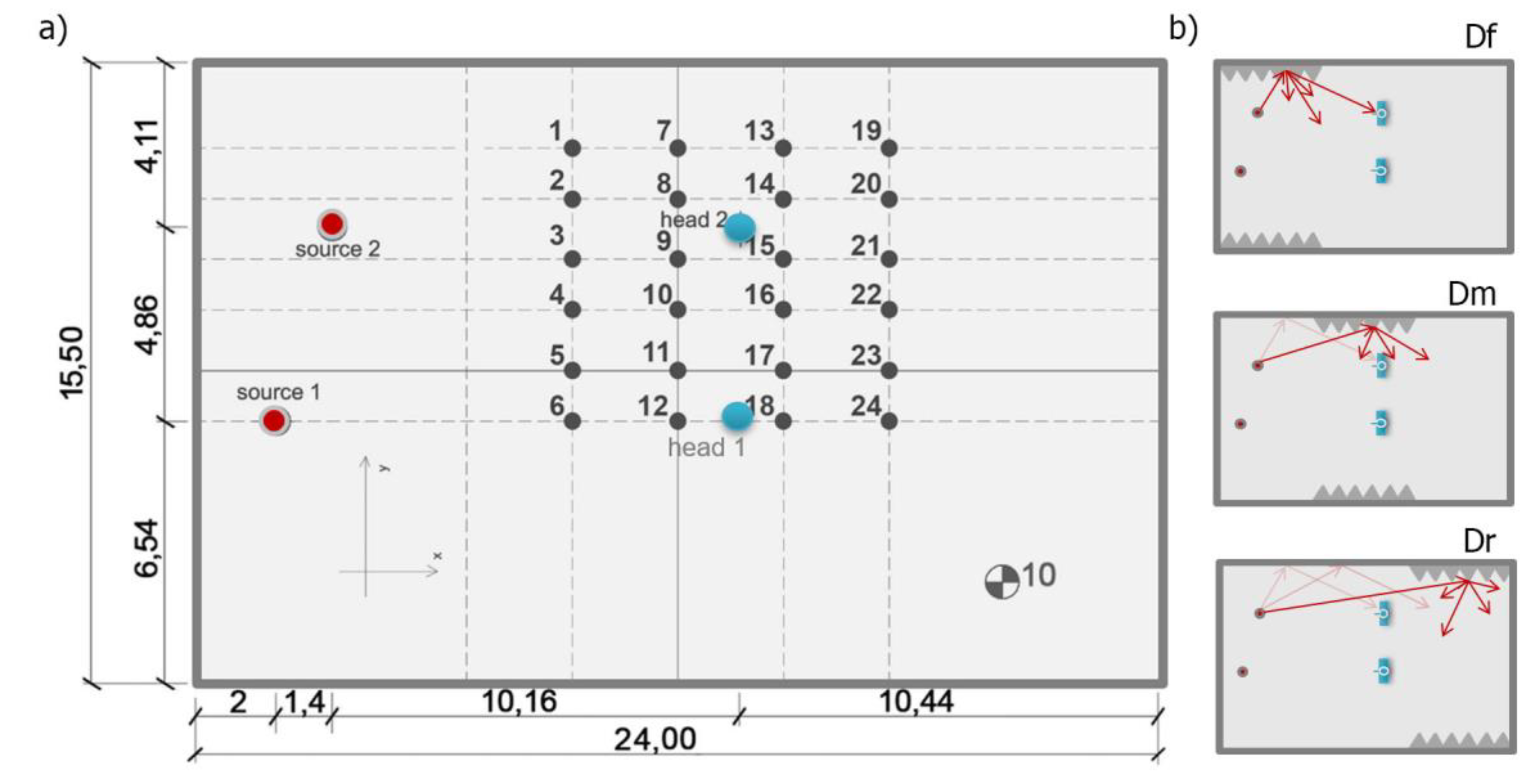
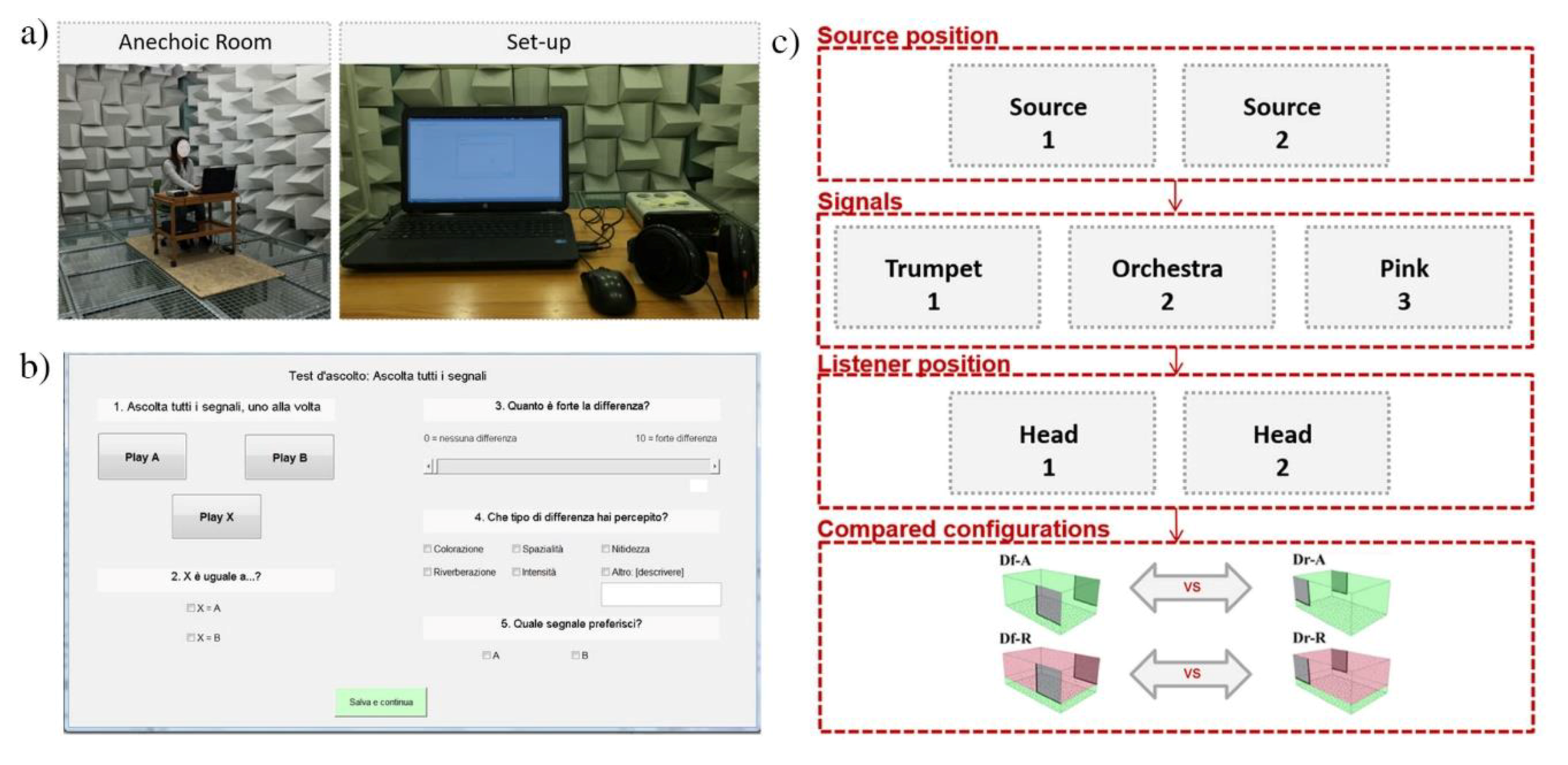
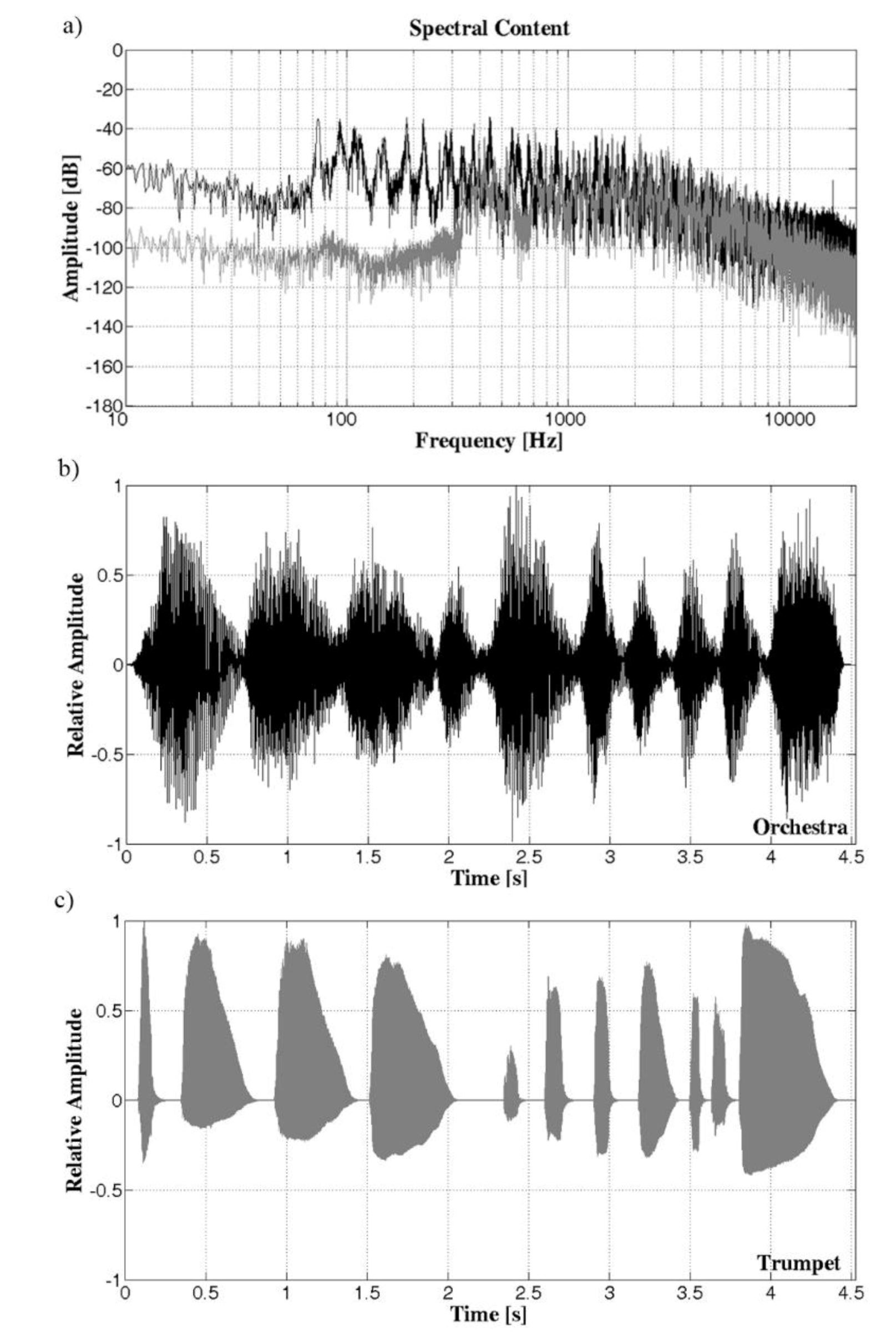
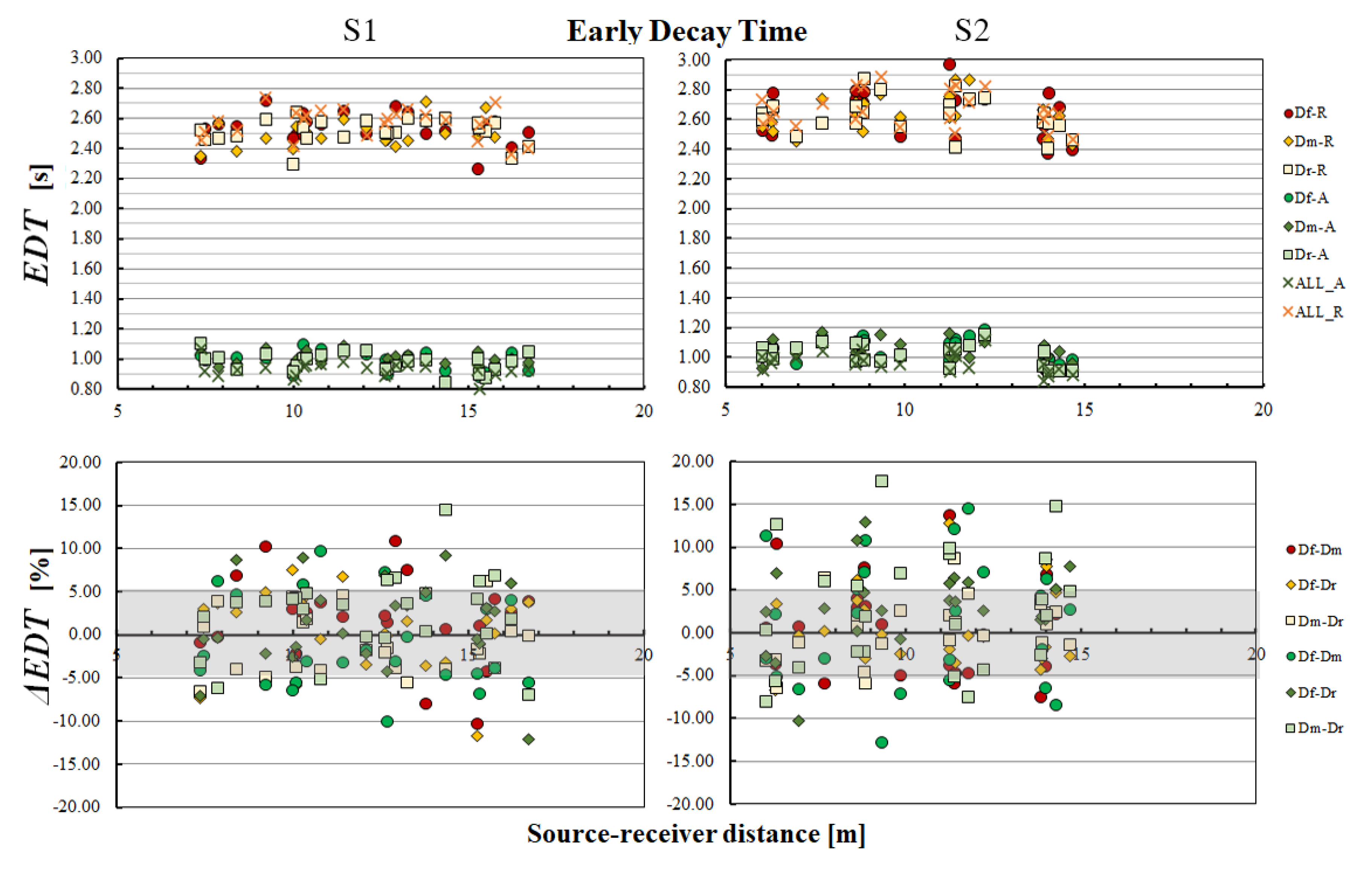

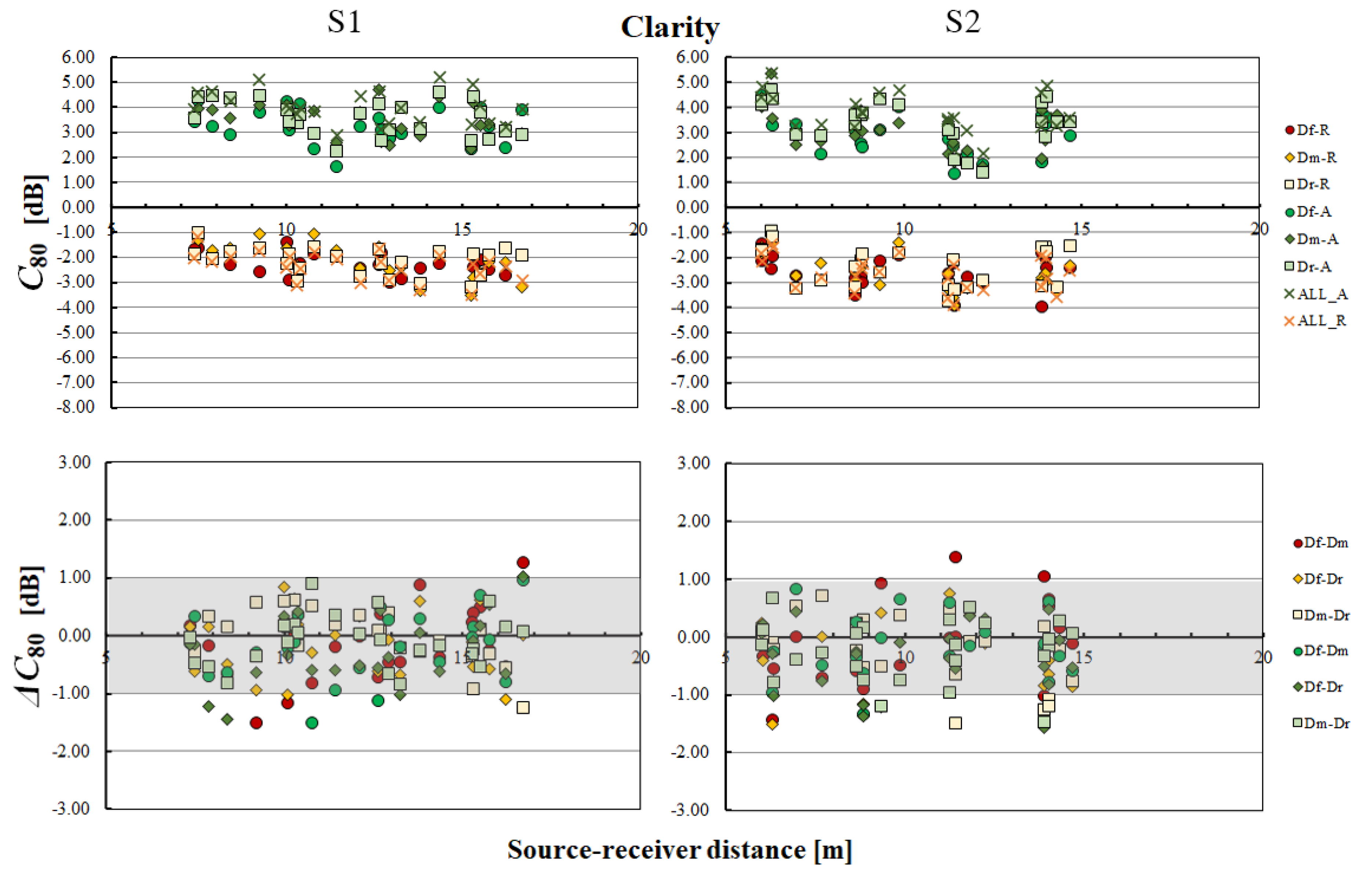
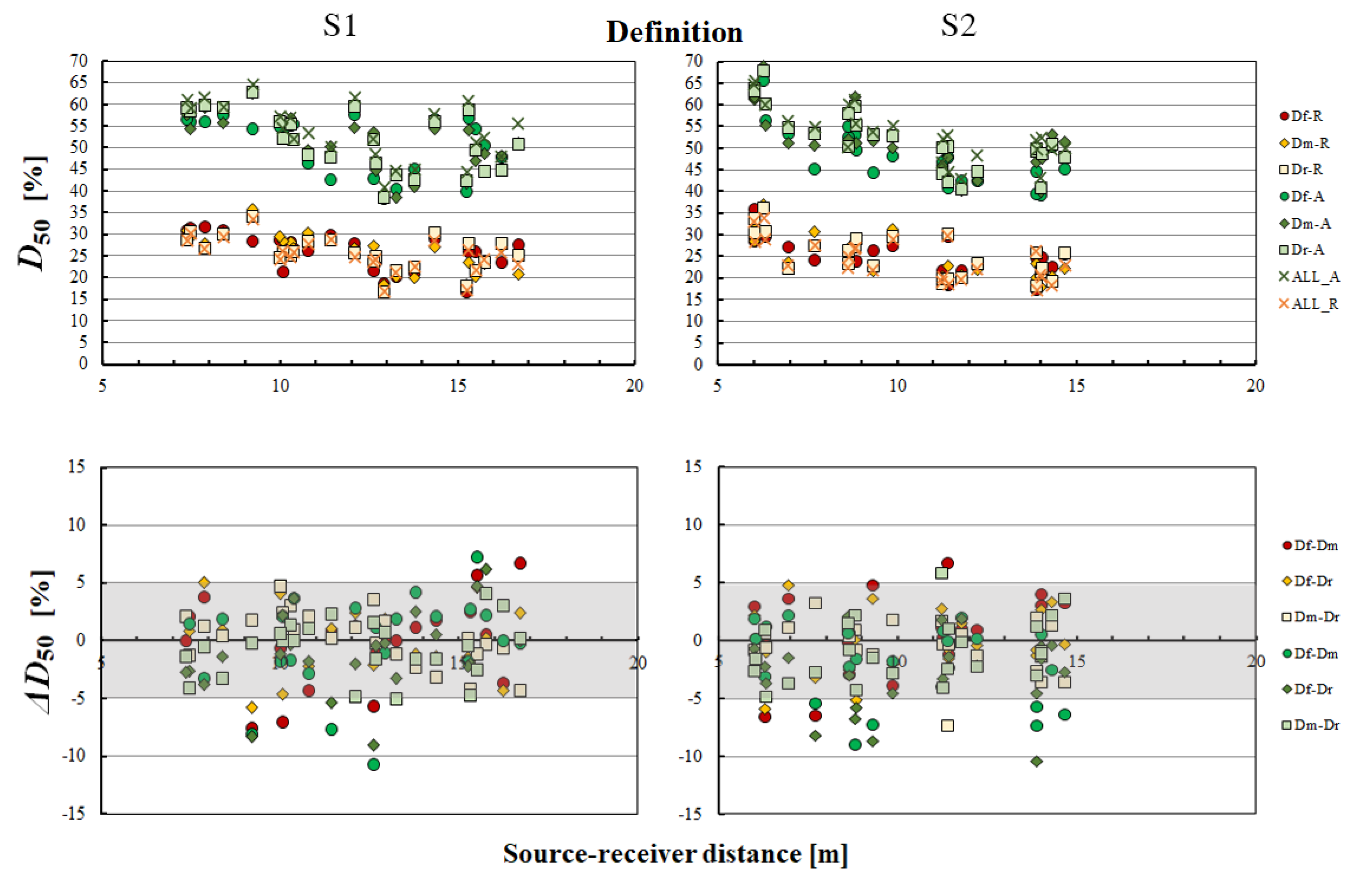
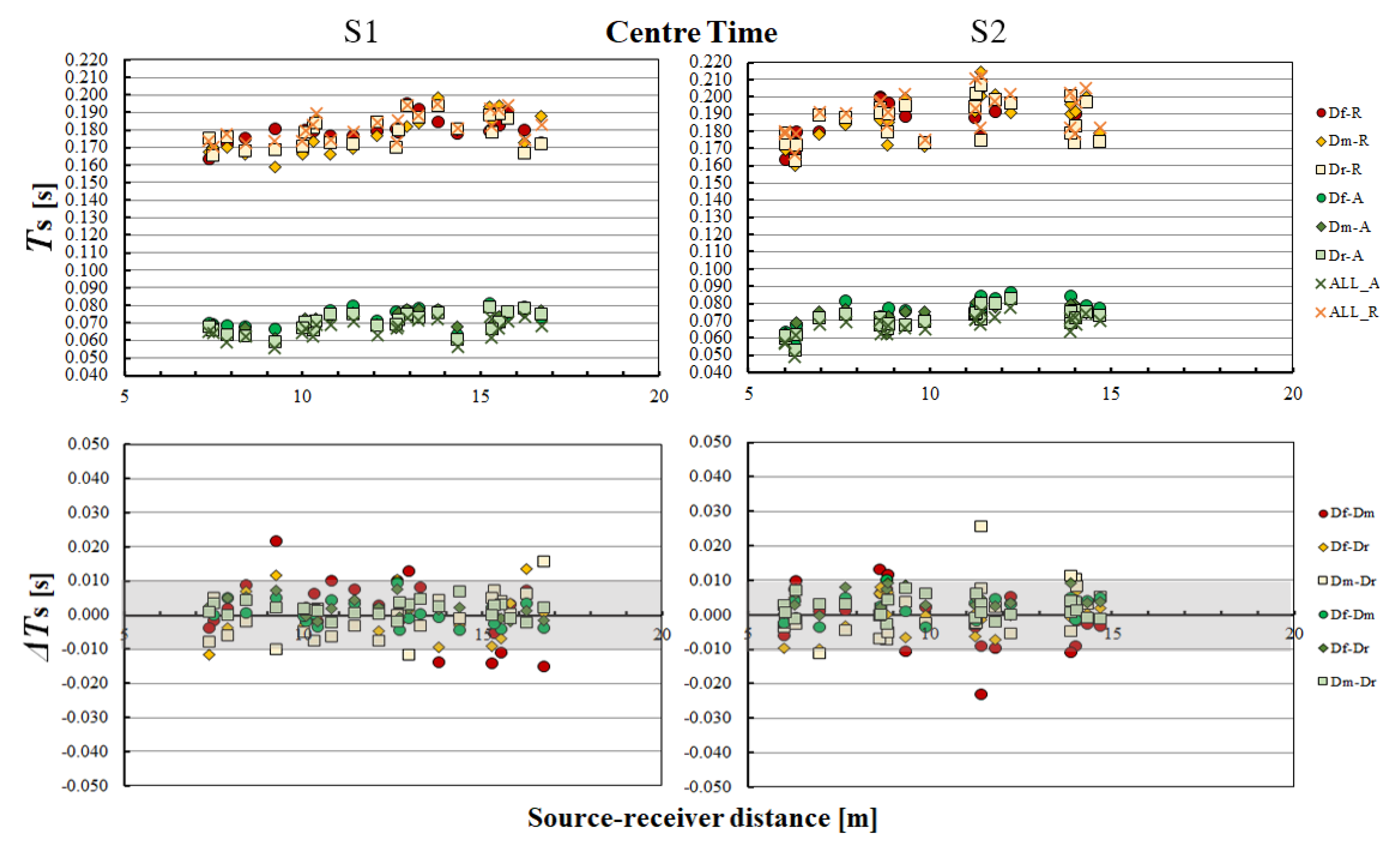
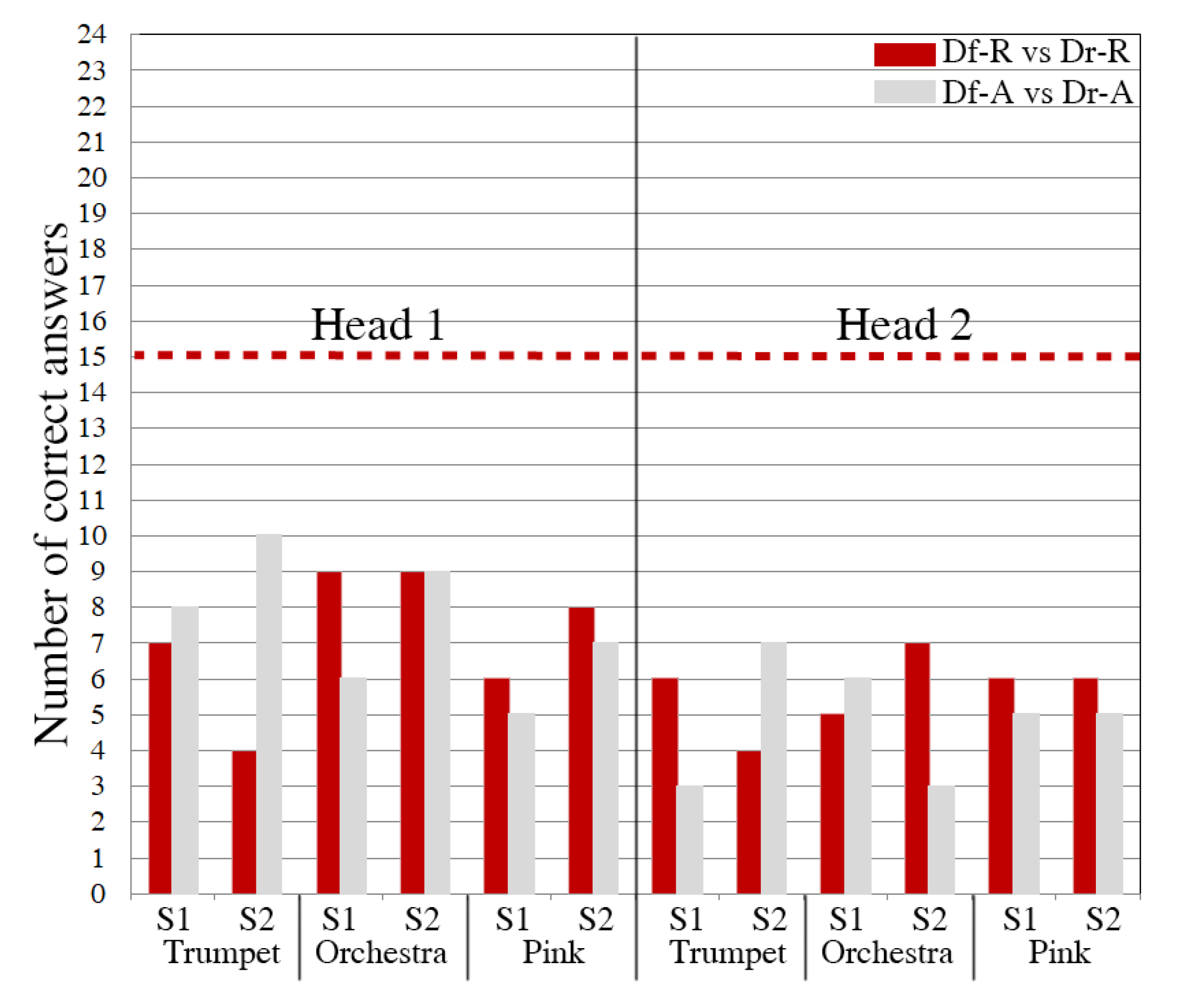

| Characteristic | Details |
|---|---|
| Use | Multipurpose |
| Plan type | Shoebox |
| Dimensions | Hvariable: Hmin = 3.5 m; Hmax = 10 m; W = 15.5 m; L = 24.0 m |
| Volume | Vmin = 818.4 m3; Vmax = 3720 m3 |
| Seats | Variable: Nmax = 350 |
| Ceiling | Variable panels: Nvp = 54 |
| Long lateral walls | Variable panels: Nvp = 49; Fixed panels: Nfp = 12 |
| Short front/rear walls | Variable panels: Nvp = 42; Fixed panels: Nfp = 12 |
| Reverberation time (500–1000 Hz) | T60, min = 0.4 s; T60, max = 4 s |
| Parameters | EDT | T30 | C80 | D50 | Ts | IACCE | IACCL | IACC |
|---|---|---|---|---|---|---|---|---|
| Units | (s) | (s) | (dB) | (%) | (s) | (-) | (-) | (-) |
| JND | 5% | 5% | 1 dB | 5% | 0.010 | 0.075 | 0.075 | 0.075 |
| EDT * [s] | T30 * [s] | C80 [dB] | D50 [%] | Ts [s] | |||||||
|---|---|---|---|---|---|---|---|---|---|---|---|
| Mean | SD | Mean | SD | Mean | SD | Mean | SD | Mean | SD | ||
| Source 1 | All-A | 0.92 | 0.06 | 1.04 | 0.02 | 4.0 | 0.6 | 53.9 | 6.4 | 0.066 | 0.005 |
| All-R | 2.57 | 0.10 | 2.76 | 0.06 | −2.3 | 0.6 | 25.2 | 3.8 | 0.182 | 0.008 | |
| Df-R | 2.53 | 0.10 | 2.75 | 0.08 | −2.3 | 0.5 | 25.8 | 4.2 | 0.179 | 0.007 | |
| Δ | (1.6) | (0.4) | (0.0) | (−0.6) | (0.003) | ||||||
| Dm-R | 2.49 | 0.09 | 2.74 | 0.07 | −2.1 | 0.7 | 26 | 4.5 | 0.178 | 0.01 | |
| Δ | (3.1) | (0.7) | (−0.2) | (−0.8) | (0.004) | ||||||
| Dr-R | 2.52 | 0.08 | 2.73 | 0.06 | −2.1 | 0.6 | 25.7 | 4.0 | 0.179 | 0.009 | |
| Δ | (1.9) | (1.1) | (−0.2) | (−0.5) | (0.003) | ||||||
| Df-A | 0.99 | 0.06 | 1.10 | 0.02 | 3.3 | 0.7 | 50.7 | 6.4 | 0.072 | 0.005 | |
| Δ | (−7.6) | (−5.8) | (0.7) | (3.2) | (−0.006) | ||||||
| Dm-A | 1.00 | 0.05 | 1.10 | 0.02 | 3.5 | 0.6 | 51.0 | 6.4 | 0.072 | 0.005 | |
| Δ | (−8.7) | (−5.8) | (0.5) | (2.9) | (−0.006) | ||||||
| Dr-A | 0.98 | 0.06 | 1.08 | 0.02 | 3.6 | 0.7 | 51.7 | 6.8 | 0.07 | 0.006 | |
| Δ | (−6.5) | (−3.8) | (0.4) | (2.2) | (−0.004) | ||||||
| Source 2 | All-A | 0.97 | 0.07 | 1.05 | 0.03 | 3.8 | 0.8 | 53.8 | 7.0 | 0.067 | 0.006 |
| All-R | 2.66 | 0.12 | 2.89 | 0.1 | −2.6 | 0.7 | 24.2 | 4.8 | 0.191 | 0.012 | |
| Df-R | 2.64 | 0.15 | 2.87 | 0.13 | −2.6 | 0.6 | 24.9 | 4.2 | 0.186 | 0.012 | |
| Δ | (0.8) | (0.7) | (0.0) | (−0.7) | (0.005) | ||||||
| Dm-R | 2.64 | 0.12 | 2.90 | 0.13 | −2.6 | 0.7 | 24.7 | 5.0 | 0.187 | 0.013 | |
| Δ | (0.8) | (−0.3) | (0.0) | (−0.5) | (0.004) | ||||||
| Dr-R | 2.63 | 0.12 | 2.88 | 0.11 | −2.4 | 0.8 | 25.1 | 5.0 | 0.186 | 0.012 | |
| Δ | (1.2) | (0.3) | (−0.2) | (−0.9) | (0.005) | ||||||
| Df-A | 1.05 | 0.07 | 1.12 | 0.02 | 3.0 | 0.8 | 49.2 | 7.3 | 0.075 | 0.007 | |
| Δ | (−8.2) | (−6.7) | (0.8) | (4.6) | (−0.008) | ||||||
| Dm-A | 1.04 | 0.07 | 1.11 | 0.03 | 3.2 | 0.9 | 51.3 | 7.1 | 0.072 | 0.007 | |
| Δ | (−7.2) | (−5.7) | (0.6) | (2.5) | (−0.005) | ||||||
| Dr-A | 1.02 | 0.07 | 1.10 | 0.02 | 3.4 | 0.9 | 52.1 | 7.3 | 0.070 | 0.007 | |
| Δ | (−5.2) | (−4.8) | (0.4) | (1.7) | (−0.003) | ||||||
| Parameters | EDT | T30 | C80 | D50 | Ts | IACCE | IACCL | IACC | |
|---|---|---|---|---|---|---|---|---|---|
| Units | (s) | (s) | (dB) | (%) | (s) | (-) | (-) | (-) | |
| JND | 5% R ≈ 0.10 s A ≈ 0.05 s | 5% R ≈ 0.10 s A ≈ 0.05 s | 1 dB | 5% | 10 ms | 0.075 | 0.075 | 0.075 | |
| S1—Head 1 | Df-R | 2.51 | 2.71 | −2.3 | 22 | 0.180 | 0.436 | 0.117 | 0.223 |
| Dm-R | 2.45 | 2.81 | −1.6 | 27 | 0.170 | 0.439 | 0.149 | 0.220 | |
| Dr-R | 2.51 | 2.70 | −1.7 | 24 | 0.170 | 0.448 | 0.104 | 0.196 | |
| Df-A | 0.99 | 1.12 | 3.6 | 43 | 0.077 | 0.611 | 0.168 | 0.428 | |
| Dm-A | 0.93 | 1.10 | 4.7 | 54 | 0.067 | 0.605 | 0.232 | 0.466 | |
| Dr-A | 0.93 | 1.10 | 4.1 | 52 | 0.069 | 0.617 | 0.251 | 0.458 | |
| S1—Head 2 | Df-R | 2.57 | 2.76 | −2.6 | 21 | 0.188 | 0.350 | 0.158 | 0.178 |
| Dm-R | 2.58 | 2.70 | −2.9 | 20 | 0.191 | 0.367 | 0.125 | 0.188 | |
| Dr-R | 2.59 | 2.71 | −2.6 | 22 | 0.190 | 0.408 | 0.158 | 0.210 | |
| Df-A | 1.03 | 1.08 | 3.1 | 43 | 0.078 | 0.478 | 0.153 | 0.349 | |
| Dm-A | 1.01 | 1.08 | 3.0 | 40 | 0.078 | 0.430 | 0.177 | 0.301 | |
| Dr-A | 0.99 | 1.06 | 3.6 | 43 | 0.074 | 0.545 | 0.140 | 0.407 | |
| S2—Head 1 | Df-R | 2.73 | 2.73 | −2.8 | 23 | 0.196 | 0.408 | 0.120 | 0.190 |
| Dm-R | 2.74 | 2.73 | −3.0 | 22 | 0.191 | 0.414 | 0.124 | 0.215 | |
| Dr-R | 2.75 | 2.75 | −2.9 | 23 | 0.196 | 0.358 | 0.127 | 0.172 | |
| Df-A | 1.18 | 1.10 | 1.7 | 43 | 0.086 | 0.426 | 0.214 | 0.315 | |
| Dm-A | 1.10 | 1.08 | 1.6 | 42 | 0.083 | 0.486 | 0.192 | 0.351 | |
| Dr-A | 1.15 | 1.08 | 1.4 | 45 | 0.083 | 0.435 | 0.140 | 0.319 | |
| S2—Head 2 | Df-R | 2.81 | 2.91 | −3.0 | 21 | 0.195 | 0.464 | 0.162 | 0.250 |
| Dm-R | 2.68 | 2.94 | −3.0 | 20 | 0.196 | 0.437 | 0.190 | 0.257 | |
| Dr-R | 2.67 | 2.93 | −3.4 | 19 | 0.198 | 0.450 | 0.193 | 0.264 | |
| Df-A | 1.04 | 1.13 | 2.9 | 46 | 0.078 | 0.546 | 0.225 | 0.393 | |
| Dm-A | 1.09 | 1.13 | 2.8 | 48 | 0.077 | 0.535 | 0.260 | 0.419 | |
| Dr-A | 0.99 | 1.12 | 3.1 | 47 | 0.074 | 0.595 | 0.295 | 0.457 | |
© 2020 by the authors. Licensee MDPI, Basel, Switzerland. This article is an open access article distributed under the terms and conditions of the Creative Commons Attribution (CC BY) license (http://creativecommons.org/licenses/by/4.0/).
Share and Cite
Shtrepi, L.; Di Blasio, S.; Astolfi, A. Listeners Sensitivity to Different Locations of Diffusive Surfaces in Performance Spaces: The Case of a Shoebox Concert Hall. Appl. Sci. 2020, 10, 4370. https://doi.org/10.3390/app10124370
Shtrepi L, Di Blasio S, Astolfi A. Listeners Sensitivity to Different Locations of Diffusive Surfaces in Performance Spaces: The Case of a Shoebox Concert Hall. Applied Sciences. 2020; 10(12):4370. https://doi.org/10.3390/app10124370
Chicago/Turabian StyleShtrepi, Louena, Sonja Di Blasio, and Arianna Astolfi. 2020. "Listeners Sensitivity to Different Locations of Diffusive Surfaces in Performance Spaces: The Case of a Shoebox Concert Hall" Applied Sciences 10, no. 12: 4370. https://doi.org/10.3390/app10124370
APA StyleShtrepi, L., Di Blasio, S., & Astolfi, A. (2020). Listeners Sensitivity to Different Locations of Diffusive Surfaces in Performance Spaces: The Case of a Shoebox Concert Hall. Applied Sciences, 10(12), 4370. https://doi.org/10.3390/app10124370







